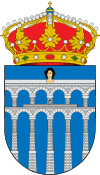Segovia
| Segovia | |||
|---|---|---|---|
| Municipality | |||
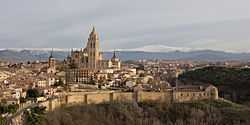 | |||
| |||
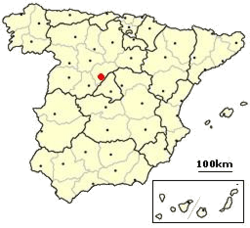 | |||
 Segovia | |||
| Coordinates: 40°57′N 4°10′W / 40.950°N 4.167°WCoordinates: 40°57′N 4°10′W / 40.950°N 4.167°W | |||
| Country |
| ||
| Autonomous community |
| ||
| Province | Segovia | ||
| Comarca | Capital y Área Metropolitana | ||
| Judicial district | Partido de Segovia | ||
| Government | |||
| • Alcalde | Pedro Arahuetes García (PSOE) | ||
| Area | |||
| • Total | 163.59 km2 (63.16 sq mi) | ||
| Elevation | 1,000 m (3,000 ft) | ||
| Population (2009) | |||
| • Total | 56,660 | ||
| • Density | 350/km2 (900/sq mi) | ||
| Demonym | Segoviano, na | ||
| Time zone | CET (UTC+1) | ||
| • Summer (DST) | CEST (UTC+2) | ||
| Postal code | 40001-40006 | ||
| Official language(s) | Spanish | ||
| Website | Official website | ||
Segovia (Spanish pronunciation: [seˈɣoβja]) is a city in the autonomous region of Castile and León, Spain. It is the capital of Segovia Province.
Etymology
The name of Segovia is of Celtiberian origin. The first inhabitants named the city Segobriga. This name comes from two terms of the Celtiberian language of the Celtic branch of Indo-European. The term Sego means «victory» (the prefix is also present in other city names such as Segeda and Segontia, cf. German "Sieg") and the suffix -briga would mean «city» or «strength». So the name might be translated as "City of the victory" or "Victorious city".
Under the Romans and Arabs, the city was called Segovia (Σεγουβία, Ptolomeo ii. 6. § 56) and Šiqūbiyyah (Arabic شقوبية) respectively.
Geography
Location
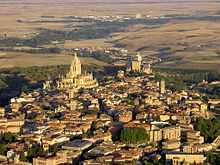
Segovia is located within the Iberian Peninsula, near Valladolid and the Spanish capital, Madrid.
Segovia is one of nine provinces that make up the autonomous region of Castile and León. It is neighboured by Burgos and Valladolid to the north, Ávila to the west, Madrid and Guadalajara to the south and Soria to the east. The altitude of the province varies from 750 metres (2,461 feet) in the extreme northwest to a maximum of 2,430 m (7,972 ft) at Peñalara peak.
The town is part of the main route of the Camino de Santiago de Madrid.
Climate
The climate is continental Mediterranean, cold and dry, resulting from the high altitude and the distance from the coast. The average annual temperature is 11.5 °C (52.7 °F), with an absolute minimum in December of −14 °C (6.8 °F) and maximum in August of 39 °C (102.2 °F). The annual precipitation is 520 mm (20 inches) per year, making the province a damp corner in the context of the region. The predominant forms of vegetation in the mountainous areas include pine, evergreen, oak, beech and juniper.
History


Segovia was first recorded as a Celtic possession, with control eventually transferring into the hands of the Romans. The city is a possible site of the battle in 75 BCE where Metellus was victorious over the general of Sertorius, Hirtuleius. Hirtuleius died in the fighting.[1]
During the Roman period the settlement belonged to one of numerous contemporary Latin convents. It is believed that the city was abandoned after the Islamic invasion of Spain centuries later. After the conquest of Toledo by Alfonso VI of León and Castile, the son of King Alfonso VI, Segovia began restocking with Christians from the north of the peninsula and beyond the Pyrenees, providing it with a significant sphere of influence whose boundaries crossed the Sierra de Guadarrama and the Tagus.
Segovia's position on trading routes made it an important center of trade in wool and textiles. The end of the Middle Ages saw something of a golden age for Segovia, with a growing Jewish population and the creation of a foundation for a powerful cloth industry. Several splendid works of Gothic architecture were also completed during this period. Notably, Isabella I was proclaimed queen of Castile in the church of San Miguel de Segovia on December 13, 1474.
Like most Castilian textile centers, Segovia joined the Revolt of the Comuneros under the command of Juan Bravo. Despite the defeat of the Communities, the city's resultant economic boom continued into the sixteenth century, its population rising to 27,000 in 1594. Then, as well as almost all the cities of Castile, Segovia entered a period of decline. Only a century later in 1694, the population had been reduced to only 8,000 inhabitants. In the early eighteenth century, Segovia attempted to revitalize its textile industry, with little success. In the second half of the century, Charles III made another attempt to revive the region's commerce; it took the form of the Royal Segovian Wool Manufacturing Company (1763). However, the lack of competitiveness of production caused the crown withdraw its sponsorship in 1779. In 1764, the Royal School of Artillery, the first military academy in Spain, was opened. This academy remains present in the city today. In 1808, Segovia was sacked by French troops during the War of Independence. During the First Carlist War, troops under the command of Don Carlos unsuccessfully attacked the city. During the nineteenth and first half of the twentieth century, Segovia experienced a demographic recovery that was the result of relative economic stability.
Demographics
The population growth experienced during the nineteenth century accelerated steadily beginning around 1920: 16,013 inhabitants that year, 33,360 in 1960, 53,237 in 1981. Since the 1980s growth has slowed markedly: 55,586 in 2004 and 56,047 in 2007.
Heritage
World Heritage City

| Old Town of Segovia and its Aqueduct | |
|---|---|
| Name as inscribed on the World Heritage List | |
| Type | Cultural |
| Criteria | i, iii, iv |
| Reference | 311 |
| UNESCO region | Europe and North America |
| Inscription history | |
| Inscription | 1985 (9th Session) |
In 1985 the old city of Segovia and its Aqueduct were declared World Heritage by UNESCO. Within the environment of the old city, stand diversity of historic buildings both civil and religious, not just catholics but also Jews, like the district that served this minority, which commemorates the different cultures in the city. One of the best examples of this cultural diversity is represented by the former synagogue, now the church of Corpus, and the Jewish cemetery located in "El Pinarillo" with its interpretation center in the most important Jewish palace of the Spanish aljamas, the chief accountant Meir Melamed, son-in-law and successor of Abraham Senior, chief rabbi of the Kingdom of Castile, Melamed after converting to Christianity under the name of Fernán Núñez Coronel, was alderman of the city and occupied important positions in the kingdom. Among its monuments are:
The Aqueduct of Segovia, located in the much-visited Plaza del Azoguejo, is the defining historical feature of the city, dating from the late 1st or early 2nd century.[2] Acknowledged as the most important Roman civil engineering work in Spain, it consists of about 25,000 granite blocks held together without any mortar, and spans 818 meters with more than 170 arches, the highest being 29 meters high.
The Alcazar of Segovia, the royal palace located on top of a rock between the rivers Eresma and Clamores, is documented for the first time in 1122, although it may exist in earlier time. It was one of the favorite residences of the kings of Castile, built in the transition from Romanesque to Gothic and Mudéjar decor highlighting its ample rooms. The building is structured around two courtyards and has two towers, the Keep and John II. It was a favorite residence of Alfonso X the Wise and Henry IV, and Isabella the Catholic left him to be crowned Queen of Castile in the main square. Devastated by fire in 1862, was later rebuilt. Now houses the General Militar de Segovia archive and museum of the Royal School of Artillery, managed by the Board of the Alcazar.

The Segovia Cathedral is the last Gothic cathedral built in Spain. It is considered the masterpiece of Basque-Castilian Gothic and is known as "The Lady of Cathedrals." This is the third largest cathedral in the city,[citation needed] and retains the cloister of the second, located opposite the castle and destroyed during the Revolt of the Comuneros in 1520. In his works he worked Juan and Rodrigo Gil de Hontañón, and other teachers of Spanish architecture. It was consecrated in 1768 and has dimensions of 105 meters long, 50 meters wide and 33 high in the nave, has 18 chapels and has three doors: El Perdón, San Frutos and San Geroteo, first bishop of the diocese.
The Walls of Segovia existed when Alfonso VI of León and Castile took the city to the Arabs, who commanded a larger coming to have a perimeter of 3 kilometers, eighty towers, five doors and several doors. It was built mainly with granite blocks, but also reused gravestones of the Roman necropolis. The wall runs along the old, and currently maintains three doors: San Cebrián, of great austerity, Santiago, of Mudéjar looking, and San Andrés, gateway to the Jewish quarter, and the breaches of Consuelo, San Juan, the Sun and Moon.
Religious architecture


The city maintains an important collection of Romanesque churches of both stone and brick, which include San Esteban, San Millán, San Martín, la Santísima Trinidad, San Andrés, San Clemente, Santos Justo y Pastor, la Vera Cruz and San Salvador and others . It also retains many convents and monasteries such as San Antonio el Real, del Parral or San Vicente el Real.
The Old main synagogue is a remainder of Jewish Segovia.
Civil architecture
- The Ayala Berganza Castilian Palace dating from the late 15th century, declared a Historic-Artistic Monument, now converted into tourist accommodation, Carretas street, 5. Due to a multiple murder happened in the late 19th century is known by Segovia as "the house of the crime."
- The civil architecture, with many palaces, medieval façades, doorways, patios, columns, shields and turrets. It can highlight a number of covers on the Daoíz street, the Casa del Sello in the San Francisco street, the Casa-Museo del Torreón de Lozoya in the Plaza de San Martín, the Casa del Siglo XV (or of Juan Bravo), the House of the Count Alpuente (City council), the Casa de los Picos and others in the Calle Real.
- The traditional civil architecture in Segovia style tile roof and decorated in the traditional sgraffiti on the walls.
- The oldest tavern in the town dates from 1861 and is La Taberna Rubi, located a few steps from the Plaza Mayor.
- The Casa de la Moneda, the oldest industrial building in Europe.
Urban sculpture

Urban Sculpture in Segovia stars works depicting illustrious figures linked to the city, which wanted to pay tribute in this way, but we can also find several pictures of a religious nature. One of the most iconic sculptures of the Loba Capitolina sits in front of the aqueduct. A copy of the Capitoline wolf is preserved in the Capitoline Museum and was a gift that Rome gave to the city in 1974 during the events of the bimillennial anniversary of the aqueduct.
In the Plaza de la Merced could be seen until a few decades ago a monument dedicated to the artist Daniel Zuloaga installed in 1924, now located in the Plaza de Colmenares. Currently located in the center of the Plaza de la Merced, looking towards the church of San Andrés is a bust of the poet Rubén Darío, sculptor Santiago de Santiago, which was donated by the Nicaragua government to the city in 1973. Letters related to the bust are also found in the Promenade Lounge, the famous poet José Rodas was first installed in 1927 in the plaza of the gardens, and moved to its present site in 1960 by the segovian sculptor Aniceto Marinas. It could not miss this literary group a tribute to Antonio Machado, poet Segovia made his refuge from 1919 to 1932, the sculpture as it could be otherwise is located in the garden of his home museum, and was done by Emiliano Barral.
Religious figures such as Domingo de Soto, Pius XII, Saint Anthony Mary Claret, Saint John of the Cross have their place within the city urban sculpture, the first work of Ortega and the rest of José María García Moro, sculptor prosperous Segovia who must also be a Monument to the Youth located in the Plaza del Conde de Cheste. Other teachers who also paid tribute to his work a few peasants have been both recognized in any street or town square, as is the case for Aniceto Marinas, who dedicated a monument in 1943 his friend and partner Mariano Benlliure.
In the field of arms found the monument to Daoíz and Velarde, Aniceto Marinas work. By the same author is the List of people associated with the comunero Juan Bravo sculpture, made in 1921 and located in the heart of the city in the Square of the Sirens, the name given to two statues that top the stairs and representing these mythological beings, made by Francisco Bellver in 1852. Other sculptures in the city are devoted to medical Andrés Laguna made by the segovian Florentino Trapero and marina located in Plaza de los Huertos, the bust of Lope de la Calle Martín, president of the Provincial council that made Emiliano Barral and can be seen in the square of San Facundo or the monument "El Favorito", by Toribio García de Andrés in the early of 20th century.
In addition to this series of monuments and sculptures are hidden in the corners of the city some other religious images that are worth mentioning. The most significant of these is the Virgin of the Aqueduct, located in the central niche of the monument has since the Plaza del Azoguejo and it was already in the 16th century, as remember Colmenares in his history of Segovia. The cast of virgins are also members of the Fuencisla in Velarde street, the los Remedios in front of San Juan Gate, the Socorro at the San Andrés Gate or del Carmen on the street of its own name, among others.
Parks and gardens
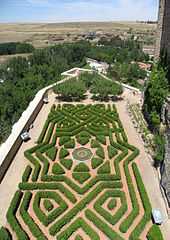

- The Alcazar Gardens was built in the plaza where the Old Cathedral and the Episcopal Palace existed before and was created on the occasion of the marriage of Philip II to Anne of Austria in 1750, removing the ruins that still existed. This, however, was not fully realized until the visit of Ferdinand VI in the 19th century. Between 1816 and 1817 the first trees were planted, and enclosed with the fence that currently exists. They were destroyed by the fire suffered by the palace in 1862, and recovered again in 1882.
- The Garden of la Merced was the first public garden carried out by the city within the city walls and currently is one of the best and most beautiful city. Named after the former Mercy convent that was located in the same place and began performing in the middle 19th century with the planting of trees and installation of a source, later replaced by the current, more broad and stately; playground available.
- Paseo del Salón is one of the oldest gardens in the city, since it was created in 1786 by the Economic Society of Friends of the Country of Segovia, and two years later they began planting trees. In 1846 he set up various sources and replanted again in different species.
- Jardinillos of San Roque, situated along the so-called "Paseo Nuevo" were open to the public in 1872, but ten years before a public fountain was placed in them. In 1943 they were the place where stood a pavilion dedicated to the Feria de Muestras, the building still stands and is one of the characteristic features of the gardens.
- The Garden of los Cañuelos a small garden which is situated opposite the School of the Missionaries, the former Convent of San Gabriel.
- The Gardens of los Huertos are named for the orchards occupy a premonstratensian friary. After the removal of the convent in 1836 with the first disentailment laws, the city claimed ownership of the land, a fact that occurred in 1897. In 1901 he began planting trees and structuring of the gardens, which has gradually been restored today.
- Alameda del Eresma
- Alameda de la Fuencisla
- Fromkes Garden
- Garden of la Plaza del Conde Alpuente
- Garden of la Plaza de Colmenares
- Garden of St. Augustine
- Parque de la Albuera
- Parque de la Dehesa
- Pinarillo de la Cuesta de los Hoyos
- Clamores Valley
Economy
The economy of Segovia revolves around metallurgy, agriculture, furniture, construction and, particularly, tourism. The town itself plays host to thousands of day-visitors from Madrid each year.
Education
The city of Segovia is home to a large number of primary schools and secondary schools, the oldest of which (IES Mariano Quintanilla, founded in 1845) having been officially declared "of cultural interest." A high proportion of the student population attends state primary and secondary schools, while private schooling in Segovia is mostly religious in nature.
Regarding higher education, Segovia's premier institution is IE University, a business-oriented undergraduate university, building upon Instituto Empresa's successful MBA program at Madrid-based IE Business School. Also present is the Segovia campus of the University of Valladolid, offering entrance into careers in computer engineering, law, journalism, advertising and teaching. I
Culture
Museums
- Museum of Segovia.
- Museum of Contemporary Art 'Esteban Vicente'
- Museum of the Bishop's Palace
- Museum of the Artillery Academy
- Museum of the Cathedral
- Museum Zuloaga
- House-Museum of Antonio Machado
- Museum of the Rodera-Robles Foundation
- Museum of Witchcraft
- Museum of Arms
- Museum of the Walls of Segovia
- Jewish Center.
MUCES
MUCES is the Spanish acronym to The City of Segovia Festival of European Cinema, an annual film festival which takes place in the city since 2006, usually in November. It gives the wider public a chance to get to know quality European cinema and, above all, it offers the general public an opportunity to see European films which have not yet been commercially screened in Spain, but have been very successful with critics and audiences in their own countries.[3]
Festivities
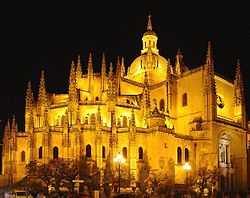
- San Lorenzo (around August 10). It is the feast of one of the most popular neighborhoods in the city.
- Fairs and Festivals of San Juan and San Pedro (late June). These feasts are the most famous feasts of the city and have been held since the 15th century.
- San Frutos (October 25): Patron saint of Segovia. At Mid-morning the Carol of San Frutos is sung in the Cathedral, after which there are often various activities in the Plaza Mayor, as a proclamation, a concert by the Band of the Segovian Musical Union, mycology exhibition, etc. In recent years, following the established tradition of drawn traditions of the sleeve, Segovia's pastry chefs have invented a dessert of the saint. On the last night to San Frutos the segovian congregate at the image of the saint who is at the door of the Cathedral to see him turning the page of the book that she holds.
- Virgin of the Fuencisla (September 25): Patronenss of Segovia. The biggest celebration day takes place during the last Sunday of the month. Two Thursdays before the Virgin up from his sanctuary in the Alameda of the Fuencisla to the Cathedral to start the novena (his arrival at the Plaza Mayor is one of the most specific one can be found in Segovia, is typical to make it when the clock of the Town Hall rings). During the nine days following celebrates the novena in the Cathedral, which is sung the Hymn of the Fuencisla, and the last Sunday in the Virgin returned to her shrine. Since the Virgin is Captain General of Artillery (which is indicated for the baton and the sash that has his feet) from the September 24, 1916, en route from the Cathedral Shrine and is accompanied by cadets Artillery Academy and the Band (which has to be brought from the Academy of Toledo since disappeared local). In its trip between the Sanctuary to the Cathedral is accompanied by the Cadets to Plaza del Azoguejo, where they sing a Salve. Until a few years had exhibitions in Castilian Jotas in the Alameda de la Fuencisla in the arrival of the Virgin; but recently Castilian Jotas are danced in the Azoguejo own.
Holy Week
Segovia has 10 fraternities, which are:
- Oración en el Huerto (own of the neighborhood of San Lorenzo)
- Resurrección del Señor (own of the neighborhood of Nueva Segovia)
- Cristo con la cruz a Cuestas (own of ADEMAR association)
- Santo Cristo de la Cruz (own of neighborhood of Cristo del Mercado)
- Santo Cristo de San Marcos (own of the neighborhood of San Marcos)
- Soledad al pie de la Cruz (own of the neighborhood of San Millán)
- Nuestra Señora de la Piedad (own of the neighborhood of San José)
- Real Cofradía de la Santa Esclavitud (own of the neighborhood of El Salvador)
- Feligresía de San Andrés (own of the neighborhood of San Andrés)
- Soledad Dolorosa (own of the neighborhood of Santa Eulalia)
Famous people
- Don Abraham Senior Coronel[4]
- Juan Bravo
- Pedro Delgado
- Nicomedes García
- Andrés Laguna
- Cándido Lopez (Mesonero Mayor de Castilla)
- Aniceto Marinas
- Manuel Pérez Brunicardi
- Cayetano Redondo Aceña
- Florentino Trapero
- Benjamín Yeo la Tercera
Sister cities
-
 Edinburgh, United Kingdom, since 1985.
Edinburgh, United Kingdom, since 1985. -
 Marysville, Ohio, United States, since 2001.
Marysville, Ohio, United States, since 2001. -
 Tucson, Arizona, United States.[5]
Tucson, Arizona, United States.[5] -
 Tours, France, since 1972
Tours, France, since 1972 -
 Gangdong-gu, Seoul, South Korea
Gangdong-gu, Seoul, South Korea
References
- ↑ From the Gracchi to Nero, H. H. Scullard, p 91 however Philip Spann disagreed - Quintus Sertorius and the Legacy of Sulla, p110
- ↑ "Arquitectura romana: Acueducto de Segovia". Historia de la Arquitectura en España. Retrieved 22 January 2009.
- ↑ "MUCES. The City of Segovia Festival of European Cinema". Retrieved January 16, 2011.
- ↑ http://www.jewishencyclopedia.com/view.jsp?letter=S&artid=474
- ↑ "Tucson Sister Cities". Interactive City Directory. Sister Cities International. Retrieved 4 September 2013.
External links
![]() Media related to Segovia at Wikimedia Commons
Media related to Segovia at Wikimedia Commons
- Official website
- Official tourism office of Segovia
- Official Language Schools of Segovia
- Segovia photo and video essay Part I and Part II
- Segovia city guide at HitchHikers Handbook
| |||||
| |||||||

